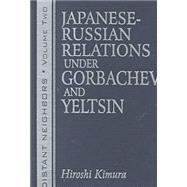
Note: Supplemental materials are not guaranteed with Rental or Used book purchases.
Purchase Benefits
Looking to rent a book? Rent Japanese-Russian Relations Under Gorbachev and Yeltsin [ISBN: 9780765605870] for the semester, quarter, and short term or search our site for other textbooks by Kimura,Hiroshi. Renting a textbook can save you up to 90% from the cost of buying.
| Acknowledgments | xi | ||||
| Abbreviations | xiii | ||||
| Introduction | xv | ||||
| PART ONE THE GORBACHEV PERIOD: NEW THINKING | 1 | (52) | |||
|
3 | (14) | |||
|
3 | (2) | |||
|
5 | (5) | |||
|
10 | (3) | |||
|
13 | (4) | |||
|
17 | (36) | |||
|
21 | (4) | |||
|
25 | (3) | |||
|
28 | (4) | |||
|
32 | (3) | |||
|
35 | (4) | |||
|
39 | (1) | |||
|
40 | (4) | |||
|
44 | (3) | |||
|
47 | (6) | |||
| PART TWO THE GORBACHEV PERIOD: THE BLOSSOM FADES | 53 | (52) | |||
|
55 | (22) | |||
|
55 | (3) | |||
|
58 | (3) | |||
|
61 | (3) | |||
|
64 | (3) | |||
|
67 | (3) | |||
|
70 | (3) | |||
|
73 | (4) | |||
|
77 | (20) | |||
|
77 | (2) | |||
|
79 | (3) | |||
|
82 | (4) | |||
|
86 | (3) | |||
|
89 | (8) | |||
|
97 | (8) | |||
|
97 | (3) | |||
|
100 | (5) | |||
| PART THREE THE YELTSIN PERIOD: THE FIRST TERM | 105 | (68) | |||
|
107 | (22) | |||
|
107 | (4) | |||
|
111 | (4) | |||
|
115 | (2) | |||
|
117 | (3) | |||
|
120 | (3) | |||
|
123 | (6) | |||
|
129 | (21) | |||
|
129 | (5) | |||
|
134 | (2) | |||
|
136 | (3) | |||
|
139 | (3) | |||
|
142 | (4) | |||
|
146 | (4) | |||
|
150 | (23) | |||
|
150 | (2) | |||
|
152 | (6) | |||
|
158 | (4) | |||
|
162 | (4) | |||
|
166 | (7) | |||
| PART FOUR THE YELTSIN PERIOD: THE SECOND TERM | 173 | (64) | |||
|
177 | (14) | |||
|
178 | (2) | |||
|
180 | (4) | |||
|
184 | (4) | |||
|
188 | (3) | |||
|
191 | (10) | |||
|
191 | (4) | |||
|
195 | (2) | |||
|
197 | (4) | |||
|
201 | (22) | |||
|
201 | (3) | |||
|
204 | (7) | |||
|
211 | (3) | |||
|
214 | (5) | |||
|
219 | (4) | |||
|
223 | (14) | |||
|
223 | (6) | |||
|
229 | (8) | |||
| PART FIVE NECESSARY CONDITIONS FOR RESOLUTION OF THE DISPUTE | 237 | (36) | |||
|
239 | (12) | |||
|
239 | (3) | |||
|
242 | (4) | |||
|
246 | (5) | |||
|
251 | (13) | |||
|
251 | (4) | |||
|
255 | (3) | |||
|
258 | (6) | |||
|
264 | (9) | |||
|
264 | (3) | |||
|
267 | (6) | |||
| Conclusion | 273 | (8) | |||
| Notes | 281 | (44) | |||
| Selected Bibliography | 325 | (16) | |||
| Name Index | 341 | (6) | |||
| Subject Index | 347 | (8) | |||
| About the Author | 355 |
The New copy of this book will include any supplemental materials advertised. Please check the title of the book to determine if it should include any access cards, study guides, lab manuals, CDs, etc.
The Used, Rental and eBook copies of this book are not guaranteed to include any supplemental materials. Typically, only the book itself is included. This is true even if the title states it includes any access cards, study guides, lab manuals, CDs, etc.